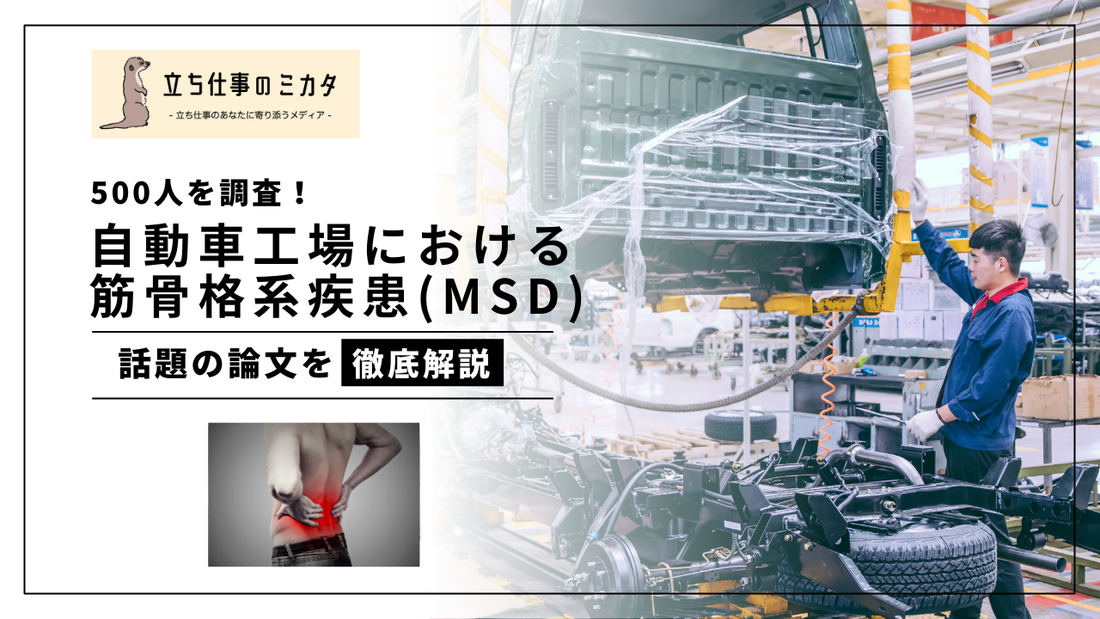
Survey of musculoskeletal disorders (MSDs) and workplace environment improvements in automobile factories
Share
Introduction
Automotive manufacturing is one of the industries with a high concentration of manual material handling (MMH) activities, including lifting, pushing, pulling and rotating , which are risk factors for musculoskeletal disorders (MSDs).
The paper introduced this time “Work-Related Musculoskeletal Disorders among Workers Performing Manual Material Handling Work in an Automotive Manufacturing Company” In a survey of workers in an automobile manufacturing plant in Malaysia, the incidence of MSDs due to MMH was This article provides an overview of the research and provides measures to improve the workplace.
Current status of musculoskeletal disorders (MSDs)
Research Background
- Workers performing MMH tasks are at high risk of developing MSDs It is believed that...
- MSDs affect nerves, tendons, muscles, and supporting structures (bones, ligaments, etc.). can affect your overall health and lead to long-term health problems.
- MSDs are said to account for more than 40% of companies' work-related injury compensation costs, and they are associated with reduced productivity. or Rising medical costs This can cause the following:
Research Methodology
The study surveyed 500 workers in an automobile manufacturing plant in Malaysia using the following methods:
-
Body Parts Symptoms Survey (BPSS)
- A questionnaire was distributed to workers to find out which areas were causing discomfort or pain.
-
Self-reported Workstation Conditions
- Find out how comfortable your working environment is and what areas need improvement.
-
Individual interviews
- Workers who visited the clinic three or more times were interviewed about the causes of MSDs and problems in the work environment.

Survey results and considerations
1. Incidence of MSDs
Survey results showed that the most commonly reported sites of MSD were:
| Body part | Very Unpleasant (%) | Extremely uncomfortable (%) |
|---|---|---|
| Lower back (lumbar) | 24.4% | 8.2% |
| Ankle/Foot | 20.8% | 6.6% |
| Upper back | 19.4% | 4.0% |
The results show that low back pain (LBP) is the most common. I found out that...
In particular, the incidence of MSD is high in departments that handle a lot of heavy objects (body assembly and engine departments). A trend was observed.
2. Causes of MSDs
The survey identified the following as the main causes of MSDs:
1) Burden from work movements
- Many of the workers performed the following tasks repeatedly:
- Lifting
- Pushing / Pulling
- Trunk Bending
- Head Lifting
- Twisting
- Extended Reach
Repeated movements like these can put strain on muscles and joints, leading to MSD. The chances are high.
② Standing for long periods of time
- Since most of the work involves standing , many workers experience pain in their lower limbs (ankles, knees, and calves). .
- Standing for long periods of time can cause poor blood flow and muscle fatigue, leading to swelling and pain in the legs. .
3) Work environment issues
- In the survey, approximately 50% of workers responded that their working environment is affected by noise and vibration.
- In particular, in departments where vibration tools such as air impact wrenches are used, there is concern about the impact of vibration on the wrists and arms .
4) Lack of awareness of ergonomics
- Approximately 76% of workers surveyed said they "don't know anything about ergonomics."
- Lack of knowledge of proper posture and lifting techniques can lead to poor working posture habits, increasing the risk of MSDs .
Prevention and remediation of MSDs
The study suggests the following specific measures to reduce the risk of MSD :
1. Teaching correct working posture and lifting techniques
- Keep your back straight and bend your knees to lift We provide work guidance based on ergonomics, such as the above.
- When lifting heavy objects, hold them as close to your body as possible This reduces the burden.
2. Improving the working environment
- Introduce height-adjustable workbenches to reduce unnecessary bending and stretching movements.
- The flooring has been changed to a cushioned material to reduce strain on the legs and back .
3. Take regular breaks and stretch
- Take a short break every hour to stretch This reduces muscle fatigue.
- Introduce leg-elevation breaks (10 minutes) to promote improved blood flow.
4. Workplace ergonomics training
- Provide workers with ergonomic training and instruct them on how to prevent MSDs.
summary
This study found that the incidence of MSDs due to MMH work is high in the Malaysian automotive manufacturing industry. has been revealed.
In particular, lower back pain is the most common, followed by pain in the ankles and upper back. The results show that:
It is important to reduce the occurrence of MSDs by improving the working environment and strengthening ergonomics education, thereby maintaining worker health and improving productivity .
